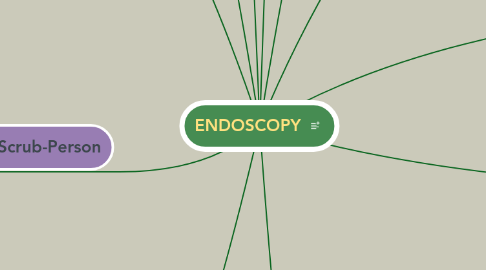
1. Definition
1.1. An examination of the body organs by using an endoscope or telescope
2. History
2.1. 936 – 1013 - Abdul Kasim - reflected light 1773 – 1809 - Philip Bozzini - light conductor 1815 – 1881 - Antonin Desormeaux - cystoscope 1848 – 1906 - Maximilian Nitze - urologist instrument 1910 - Jacobaeus - pneumoperitoneum 1924 - Richard Zollikofer - CO2 delivery through needle. 1960 - Rod-lens system leading to fibre optic system.
3. Medicolegal/Risk Factors and Safety Features
3.1. Reactions to drugs - general anaesthetic/sedation can cause reactions so check for allergies, previous anaesthetic, previous surgeries from the patient.
3.2. Injury to teeth, lips, tongue - use a bite block during a gastroscopy and remove dentures.
3.3. Hydrogen/methane gasses in colon is a cause for a possible explosion. It is flushed out with CO2 before use of electrosurgery devices.
3.4. Electric surges/fail - check all equipment before use and ensure proper maintenance is done.
3.5. Burns from projection lamp - ensure the lamp is only turned on once connected with scope and don’t let it rest on the drapes.
3.6. Endoscope maintenance - Scope and sheaths should be smooth, no nicks or breaks as it can nick mucosal surface.
3.7. Respiratory/Circulatory distress - gas absorption, trauma (bleeding) or medication Ensure all equipment and instruments are functional, properly maintained and tested before procedure.
3.8. Surgical knowledge/Equipment knowledge lacking - know what you're doing/using and stay up to date with training.
3.9. Infection - all equipment to be sterile and in clean working condition.
4. Role of the Scrub-Person
4.1. Confirm procedure, positioning, equipment and instruments needed with surgeon/surgeon preference card.
4.2. Ensure all equipment is present, sterile, and in a working condition.
4.3. Report faulty equipment/instruments immediately and remove from the theatre.
4.4. Test the endoscopic system before use -->ensure light source and camera is working, check rigid telescopes, flexible scopes (leak test), ensure CO2 cannister is full.
4.5. Confirm procedure with patient and check for allergies, previous surgeries, complications and inform the team.
4.6. Ensure Cidex is clean and within expiry date (14 days).
4.7. Set up - cleaning, draping, setting up of equipment.
4.8. Handling of laparoscopic instruments - properly assembled and working.
4.9. Cleaning of all equipment and instruments after the case - as per manufacturer guideline and company policy.
4.10. Ensure that all equipment is stored properly.
5. Relevant Policies and Procedures
5.1. There are no specific policies pertaining to endoscopy or laparoscopic procedures within the Theatre Complex at St George's.
5.2. Accepted rules:
5.3. Flexible scopes cleaned by trained staff according to manufacturer’s policies.
5.4. All endoscopic equipment cleaned by nursing staff.
5.5. Instruments cleaned by nursing staff according to level of disinfection needed.
5.6. Arthroscope, laparoscopic instruments are steam sterilized.
5.7. Camera, light cable, monopolar cable washed in Endozyme, dried and stored in cupboard.
5.8. Scrub nurse checks that all equipment is functional before the list starts.
5.9. Any problems/maintenance issues is reported to the office or maintenance department.
5.10. Cleaning of the stack is the scrub nurse’s responsibility.
6. Types
6.1. Bronchoscopy Laryngoscopy Mediastinoscopy Thoracoscopy Arthroscopy Gastroscopy Duodenoscopy Colonoscopy Laparoscopy Hysteroscopy Rigid sigmoidoscopy. Cystoscopy
7. Indications for Use
7.1. Investigation, confirmation, treatment.
7.2. GI Tract - Oesophagus, Stomach, Duodenum, Small Intestine, Colon, Bile Duct. ERCP
7.3. Respiratory tract - Rhinoscopy, Bronchoscopy.
7.4. Urinary tract - Cystoscopy.
7.5. Reproductive System - Colposcopy, Hysteroscopy, Hysterectomy, Foetoscopy, Amnioscopy.
7.6. Closed body cavities - A small incision into the abdominal or pelvic cavity, Interior joint, organs of the chest e.g. laparoscopy, arthroscopy, mediastinoscopy.
8. Components
8.1. Rigid endoscope - Eye piece, body, shaft, distal end.
8.2. Flexible endoscope - Control body, insertion tube, bending section distal tip, light guide connector unit.
8.3. Rigid endoscopes - Cystoscope, laparoscope, sinuscope, arthroscope, bronchoscope, laryngoscope, hysterscope.
8.4. Flexible scopes - Gastroscope, colonoscope, bronchoscopes.
8.5. Camera/Video Equipment - Monitor, Camera Control Unit, Camera Cable, Camera Head, Light source, Light guide cable, Telescope, Leakage tester, Insufflator.
9. Advantages
9.1. Minimally invasive. Low morbidity and mortality rate. Great visualisation of the cavity. Ability to take photos or videos. Shorter hospital stay for patient. Quicker recovery time. Resume activities of daily living quicker. Decreased pain.
10. Disadvantages
10.1. Hypercapnia. Gastric regurgitation and aspiration. Decreased respiratory effort and cardiac output. Irritation of the phrenic nerve. Injury to a body part. Bleeding. Electrical burns from ESU. Potential for DVT.
11. Maintenance
11.1. Handling
11.1.1. Delicate, expensive instrument. No rough handling, jarring, dropping, bending of parts. Don’t pile on tope of each other. Don’t mix with other instruments. Disassemble all parts thoroughly. Mechanically clean and disinfect.
11.2. Cleaning
11.2.1. Wear PPE’s Start immediately. Avoid organic debris drying. Warm water. Non residue liquid detergent. Pipe cleaner for lumens. Purging air/water channel, enzymatic cleaning solution for outside of scope and brush all valves/accessible channels. High level disinfection for flexible scopes All parts disassembled and cleaned. Dry as thoroughly as possible. Glutaraldehyde, Peracetic Acid, Ortho-Phthaladehyde. Cidex is not considered a sterilant.
11.3. Sterilization
11.3.1. Done after manual cleaning. Placed in own well padded perforated tray. Follow manufacturer guideline. Steam sterilisation - important for hollow and lumens of equipment. Gas sterilisation - ethylene oxide, formaldehyde are used in general. Flexible scopes - soaked in chemical sterilant solution e.g. Endozyme and Cidex. CAUTION - don't immerse longer than 60minutes; rinse instruments with de-ionised water; don't use tap water for rinsing as it might be chlorinated.
11.4. Storage
11.4.1. Own storage cupboard - flexible scopes stored hanging in their own cupboard. Correct storage containers - all other scopes and instruments. Clean dry conditions. Room temperature. No direct exposure to sunlight. Avoid liquids and splashes. Electrical units -->flat surface. Don’t store in: High atmospheric pressure. High/Low temperatures. High/Low humidity. Ventilation. Dust Salty/Sulfurous air.

